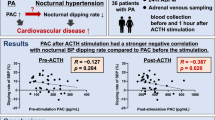Summary
Blood pressure (BP), plasma renin activity (PRA) and plasma concentration of aldosterone (PA) and cortisol (PC) were determined in essential hypertensive patients before and after β-adrenergic blockade with propranolol and prindolol. Serial measurements of PRA, PA and PC at 30 min intervals (8 p.m. to 6 a.m.) were performed in 8 patients. Administration of propranolol (50 mg three times daily) over a period of 4 weeks was followed by a significant reduction in BP, PRA and PA. PC remained unaltered. The pattern of rhythmic secretion of renin was abolished whereas that of aldosterone persisted at a lower level. Prindolol (10 mg three times daily) had a similar effect on BP as propranolol but failed to lower PRA and PA. Rhythmic secretion of renin was also markedly altered with prindolol in the absence of any change in rhythmicity of PA and PC. The hypotensive action of prindolol was not mediated via inhibition of renin release. The dissociation between PRA and PA rhythmicity indicates that during β-adrenergic blokkade diurnal rhythm of aldosterone secretion is not regulated by the renin-angiotensin-system. Rhythmicity of PC was normal, indicating that also ACTH-secretion was unaltered. Thus, under β-blockade unchanged diurnal rhythm of aldosterone may be due to normal ACTH-secretion.
Zusammenfassung
Arterieller Blutdruck, Plasma-Reninaktivität (PRA) und die Konzentration von Aldosteron (PA) und Cortisol (PC) im Plasma wurden bei 8 männlichen Patienten mit essentieller Hypertension vor und nach β-Receptorenblockade mit Propranolol und Prindolol bestimmt. Die Blutentnahme zur Bestimmung von PRA, PA und PC erfolgten halbstündlich zwischen 22.00 und 6.00 Uhr. Vor der β-Receptorenblockade fand sich ein typisches rhythmisches Verhalten von PRA, PA und PC mit relativ niedrigen Werten zwischen 22.00 und 24.00 Uhr und höheren Werten zwischen 1.00 und 4.00 Uhr. Unter einer Dosis von 3×50 mg Propranolol täglich über 4 Wochen kam es bei allen Patienten zu einer signifikanten Senkung des arteriellen Blutdruckes sowie der Pulsfrequenz. PRA und PA fielen signifikant ab. Der typische Rhythmus von PRA war nicht mehr nachweisbar. Dagegen wiesen PA und PC eine qualitativ unveränderte Rhythmik auf. Prindolol führte in einer Dosis von 3×10 mg zu einer vergleichbaren Blutdrucksenkung. Die mittlere PRA und PA blieben unverändert. Die typische Rhythmik der PRA wurde durch Prindolol ebenfalls aufgehoben, während der PA- und PC-Rhythmus unbeeinflußt blieb. Die hypotensive Wirkung von Prindolol kann nicht über eine Hemmung der PRA erklärt werden. Die Dissoziation des PRA- und des PA-Rhythmus weist darauf hin, daß unter β-Receptorenblockade die zirkadiane Rhythmik der Aldosteronsekretion nicht durch das Renin-angiotensin-System reguliert wird. Die normale Cortisolrhythmik ist mit einem unveränderten ACTH-Rhythmus vereinbar, der für die qualitativ normale zirkadiane Aldosteronsekretion unter β-Receptorenblokkade verantwortlich zu sein scheint.
Similar content being viewed by others
Literatur
Bühler, F.R., Laragh, J.H., Baer, L., Vaughan, E.D., Brunner, H.R.: Propranolol inhibition of renin secretion. N. Engl. J. Med.287, 1209 (1972)
Michelakis, A.M., Mcallister, R.G.: The effect of chronic adrenergic receptor blockade on plasma renin activity in man. J. Clin. Endocrin.34, 386 (1972)
Castenfors, J., Johnsson, H., Orö, L.: Effect of alprenolol on blood pressure and plasma renin activity in hypertensive patients. Acta med. scand.193, 189 (1973)
Pawsey, C.G.K., Wicks, J.R., Gordon, R.D., Morgan, T., Thomas, F.J., Mortimer, R.H.: The effects on plasma renin activity in patients receiving beta-sympathetic blocking drugs orally. Proc. Aust. Soc. Med. Res.2, 479 (1971).
Stokes, G.S., Weber, M.A., Thornell, I.R.: Beta-blockers and plasma renin activity in hypertension. Brit. med. J.1, 60 (1974)
Esler, D.: Effect of practolol on blood pressure and renin release in man. Clinical Pharmacology and Therapeutics,15, 484 (1973)
Vetter, H., Vetter, W.: High titre antiserum specific to aldosterone. J. Steroid Biochem.5, 197 (1974)
Haber, E., Koerner, T., Page, L.B., Kliman, B., Purnode, A.: Application of a radioimmunoassay for angiotensin I to the physiologic measurements of plasma renin activity in normal human subjects. J. clin. Endocr.29, 1349 (1969)
Vetter, W., Vetter, H., Siegenthaler, W.: Radioimmunoassay for aldosterone without chromatography. 2. Determination of plasma aldosterone. Acta endocr. (Kbh.)74, 558 (1973)
Murphy, B.E.P., Engelberg, W., Pattee, C.J.: Simple method for the determination of plasma corticoids. J. clin. Endocr.23, 293 (1963)
Weber, M.A., Stokes, G.S., Gain, J.M.: Comparison of the effects on renin release of beta adrenergic antagonists with differing properties. J. clin. Invest.54, 1413 (1974)
Werning, C., Fischer, N., Vetter, H.: Blutdruckverhalten und Plasmareninaktivität nach Gabe von Pindolol, Minoxidil und Spironolacton bei Patienten mit verschiedenen Hypertonieformen. In: Hypertension, Eds. A. Distler u. H.P. Wolff, S. 263. Georg Thieme Verlag, Stuttgart, 1974
Wesson, L.G.: Electrolyte secretion in relation to diurnal cycles of renal function. Medicine43, 547 (1964)
Ueda, H., Yasuda, H., Takabatake, Y.et al.: Increased renin release evoked by mesencephalic stimulation in the dog. Jap. Heart J.8, 498 (1967)
Passo, S.S., Assaykeen, T.A., Otsuka, K., Wise, B.L., Goldfien, A., Ganong, W.F.: Effect of stimulation of the medulla oblongata on renin secretion in dogs. Neuroendocrinology7, 1 (1971)
Kelliher, G.J., Buckley, J.P.: Central hypotensive activity of dl-and d-propranolol. J. Pharm.-Sci.59, 1276 (1970)
Author information
Authors and Affiliations
Rights and permissions
About this article
Cite this article
Stumpe, K.O., Vetter, H., Hessenbruch, V. et al. Einfluß einer chronischen β-Receptorenblockade auf Blutdruck, Renin-, Aldosteron- und Cortisolsekretion bei essentieller Hypertension. Klin Wochenschr 53, 907–911 (1975). https://doi.org/10.1007/BF01468983
Issue Date:
DOI: https://doi.org/10.1007/BF01468983




